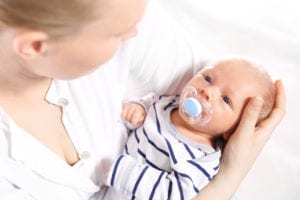Written by Joyce Smith, BS. This study investigates the effect of delivery mode (cesarean or vaginal) on the composition of gut microbiota throughout the neonatal period, and into infancy.
 The gut microbiome is a complex ecosystem of trillions of microbes, and is thought to be important for the development of the immune system. Lack of exposure to the right microbes in early childhood has been implicated in autoimmune diseases such as asthma, allergies and diabetes 1. However, it remains unkown how caesarian section versus vaginal birth might impact the initial acquisition of gut microbiota into the baby, the development of the baby’s microbiome, and subsequently, the baby’s immune system development and general health 2,3.
The gut microbiome is a complex ecosystem of trillions of microbes, and is thought to be important for the development of the immune system. Lack of exposure to the right microbes in early childhood has been implicated in autoimmune diseases such as asthma, allergies and diabetes 1. However, it remains unkown how caesarian section versus vaginal birth might impact the initial acquisition of gut microbiota into the baby, the development of the baby’s microbiome, and subsequently, the baby’s immune system development and general health 2,3.
To characterize the acquisition of gut bacteria 4, researchers studied 1,679 samples of gut bacteria from 596 full term healthy babies born in UK hospitals by vaginal delivery (314 births) or cesarean section (282 births). Fecal samples were taken at several time points; infancy, ages four, seven, or 21 days old. A subset of additional matched samples were collected from 175 mothers paired with 178 babies for further analysis.
DNA sequencing and metagenomic analysis demonstrated that the delivery mode plays a significant role in the composition of the gut microbiota throughout the neonatal (newborn) period and into infancy. Researchers discovered that vaginally delivered babies had many more health-associated (commensal) bacteria such as Bifidobacterium such as Bifidobacterium longum and Bifidobacterium breve, Escherichia coli, Bacteroides vulgatus and Parabacteroides distasonis, from their mothers than babies born by caesarean section. While cesarean section babies were deprived of maternally transmitted commensal bacteria, they had a substantially higher relative abundance of opportunistic pathogens such as Enterococcus faecalis, Enterococcus faecium, Staphylococcus epidermis, Streptococcus parasanguinis, Klebsiella oxytoca, Klebsiella pneumoniae, Enterobacter cloacae and Clostridium perfringens, all of which are commonly associated with the hospital environment 5 and with hospitalized preterm babies 6. The Shao team found that 83% of cesarean babies carried opportunistic pathogenic species during the neonatal period compared to 49.4% of vaginally delivered babies.
Although previous studies have shown that lactobacilli associated with the microbiota of the mother’s vagina were more prevalent in vaginal deliveries than in cesarean section deliveries 7,8, Shao et al found no difference. However, the team did find that commensal species from the Bacterioides genus was 51% higher (160 out of 314) in vaginally delivered babies but was low or absent in 99.6 % of cesarean babies and that these values persisted throughout infancy. An exception was the impact of prophylactic antibiotics that when given during pregnancy resulted in a significantly lower Bacterioides profile (281 out of 282) in vaginally delivered babies (P=0.0074). Also, the absence of breastfeeding during the neonatal period was associated with a higher level of C. perfringens, K. faecalis.oxytoca and E. faecalis.
When Shao et al profiled the transmission of maternal microbial strains during the infant neonatal period, they found a significantly higher transmission of maternal microbial strains in vaginally delivered babies (74% compared to 12% in cesarean section babies (P<0.0001) and that these microbes came from the mother’s gut; however, the differences in gut bacteria between vaginally delivered and cesarean delivered babies largely evened out by one year old. Large follow-up studies are needed to determine if the early differences influence health outcomes. Future large-scale, long-term cohort studies to advance our understanding of how the birth process impacts the baby’s microbiome for “at home” as well as “in hospital” births and the health outcomes in children.
Source: Shao, Yan, Samuel C. Forster, Evdokia Tsaliki, Kevin Vervier, Angela Strang, Nandi Simpson, Nitin Kumar et al. “Stunted microbiota and opportunistic pathogen colonization in caesarean-section birth.” Nature (2019): 1-5.
© The Author(s), under exclusive licence to Springer Nature Limited 2019
Posted September 30, 2019.
Joyce Smith, BS, is a degreed laboratory technologist. She received her bachelor of arts with a major in Chemistry and a minor in Biology from the University of Saskatchewan and her internship through the University of Saskatchewan College of Medicine and the Royal University Hospital in Saskatoon, Saskatchewan. She currently resides in Bloomingdale, IL.
References:
- Tamburini S, Shen N, Wu HC, Clemente JC. The microbiome in early life: implications for health outcomes. Nature medicine. 2016;22(7):713.
- Chu DM, Ma J, Prince AL, Antony KM, Seferovic MD, Aagaard KM. Maturation of the infant microbiome community structure and function across multiple body sites and in relation to mode of delivery. Nature medicine. 2017;23(3):314.
- Wampach L, Heintz-Buschart A, Fritz JV, et al. Birth mode is associated with earliest strain-conferred gut microbiome functions and immunostimulatory potential. Nature communications. 2018;9(1):5091.
- Shao Y, Forster SC, Tsaliki E, et al. Stunted microbiota and opportunistic pathogen colonization in caesarean-section birth. Nature. 2019:1-5.
- Lax S, Sangwan N, Smith D, et al. Bacterial colonization and succession in a newly opened hospital. Science translational medicine. 2017;9(391):eaah6500.
- Gibson MK, Wang B, Ahmadi S, et al. Developmental dynamics of the preterm infant gut microbiota and antibiotic resistome. Nature microbiology. 2016;1(4):16024.
- Dominguez-Bello MG, Costello EK, Contreras M, et al. Delivery mode shapes the acquisition and structure of the initial microbiota across multiple body habitats in newborns. Proceedings of the National Academy of Sciences. 2010;107(26):11971-11975.
- Dominguez-Bello MG, De Jesus-Laboy KM, Shen N, et al. Partial restoration of the microbiota of cesarean-born infants via vaginal microbial transfer. Nature medicine. 2016;22(3):250.
